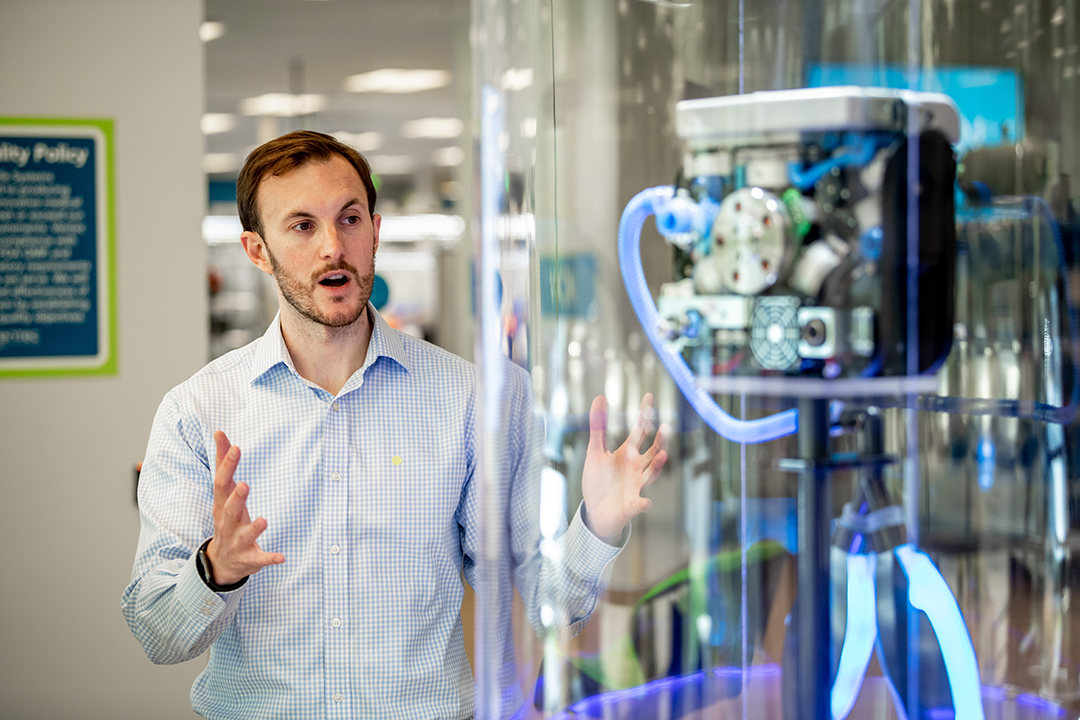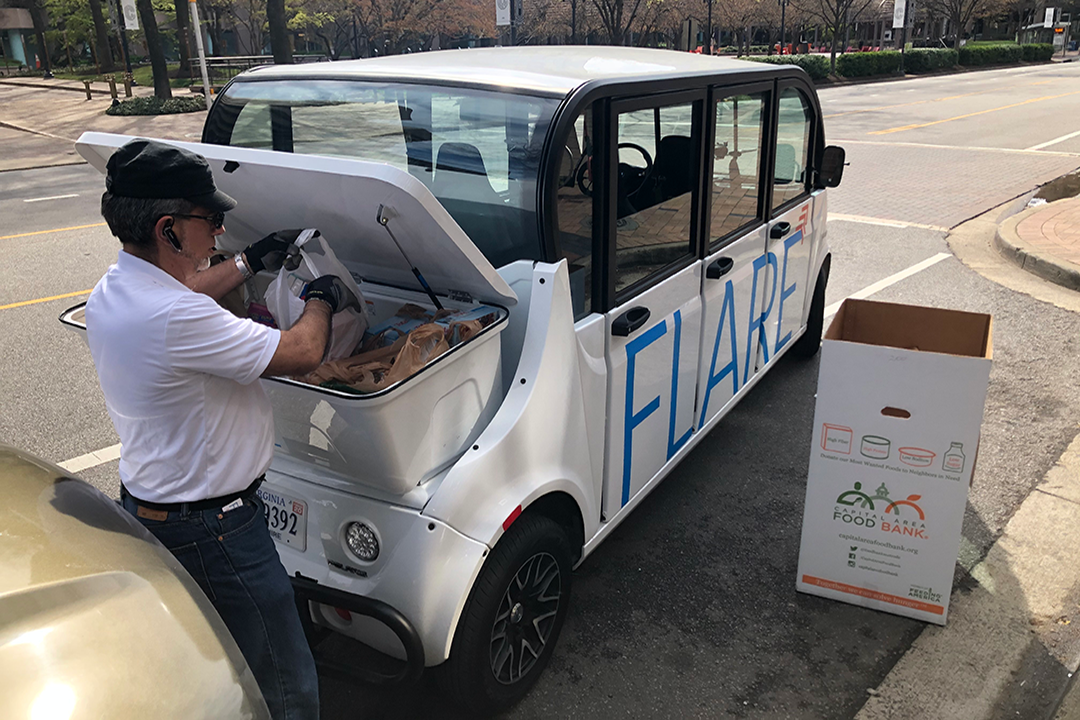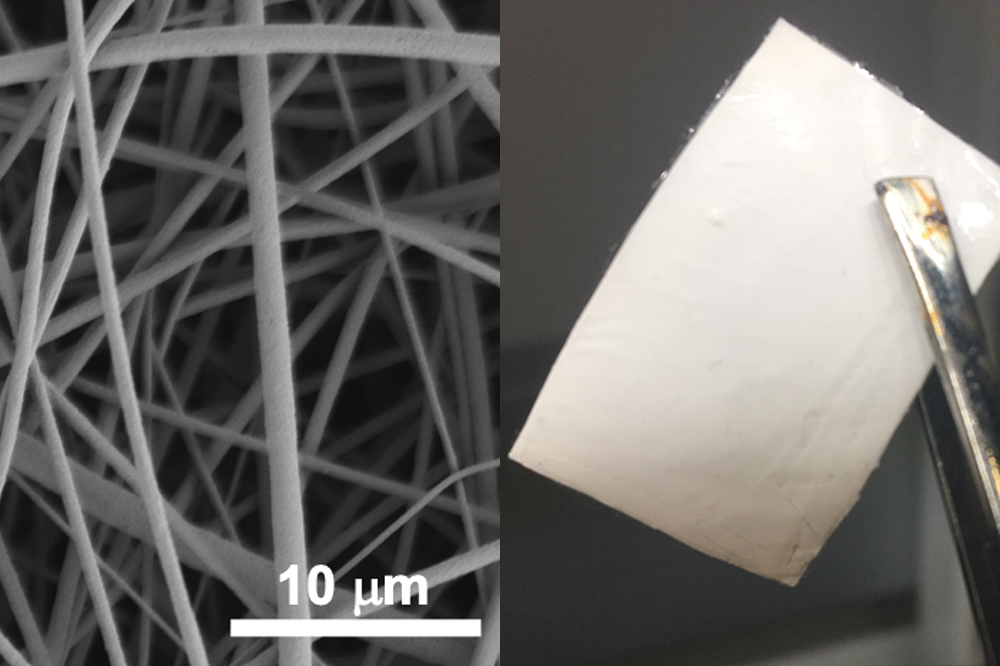By Briahnna Brown
As CEO of Ventec Life Systems, a health care equipment manufacturer, Chris Kiple, B.A. ’06, J.D. ’12, and his team set out to make a device to ease the burden for those needing respiratory care.
They created a multi-function ventilator called VOCSN, each letter representing one of the device’s functions—ventilator, oxygen concentrator, cough therapy, suction and nebulizer. Patients who require a ventilator typically require medical assistance from several machines, and the VOCSN combines that care into one device the size of a large toaster with an interface similar to a cell phone.
Mr. Kiple said that it was important to streamline that process to eliminate anxiety around caring for those who need ventilators by making a single, easy-to-use device that takes the place of several complex and precise medical devices. A lot of people working at Ventec Life Systems have a personal connection to respiratory care through family members who have needed ventilators, he said, and that pushed them to take a personal approach to creating a device to improve everyday mobility for patients and caregivers.
"We knew firsthand what it was like for not just the patient to live on a ventilator, but also the challenges that the family has to go through when you're responsible for 24-hour care for someone who can't breathe on their own,” Mr. Kiple said.
Mr. Kiple brought fellow George Washington University alumnus Chris Brooks to the team a year before VOCSN received Food and Drug Administration (FDA) clearance in 2017. Mr. Brooks, B.A. ’08, M.A. ’10, said working with a growing company already meant that they were working long hours and not getting a lot of sleep. When the novel coronavirus was still just a threat to the United States, his team had been making frequent calls to consult with respiratory therapists about what was happening in China.

Chris Brooks showcases the VOCSN device, which was designed to do the job of five different medical devices in one.
The first confirmed coronavirus death in the United States in February was less than 9 miles away from Seattle-based Ventec Life Systems. The calls with health professionals went from consultations to pleas for help, Mr. Brooks said, and numerous state government officials reached out to them for assistance. There are few suppliers that have the pre-approved technology to meet the need of a COVID-19 patient requiring a critical care ventilator, Mr. Brooks said, and he knew that the company would need to grow its manufacturing capabilities.
"We quickly realized that there's 60,000 to 80,000 ventilators made globally each year, and when you hear [New York] Gov. Cuomo saying, ‘I need 30,000 ventilators in the state of New York alone,’ it became very clear that even if all of the global manufacturers incrementally ramped production, we would not be able to meet the demand that was required for this pandemic response," Mr. Brooks said.
They needed to scale rapidly, and through a partnership with General Motors, Ventec Life Systems has been able to go from making 150 to 200 VOCSN devices per month at one facility to making up to 12,000 a month between two facilities. They are working toward meeting an order of 30,000 ventilators to go to hospitals and the U.S. Strategic National Stockpile, Mr. Brooks said, and they are continuing to scale every day.
Amid the coronavirus pandemic, Ventec Life Systems has hosted visits from Vice President Mike Pence, Transportation Secretary Elaine Chao, White House Advisor Peter Navarro, and Indiana Gov. Eric Holcomb at the manufacturing facility in Kokomo, Ind., and other meetings with the federal government bridged Washington state and Washington, D.C., for the GW alumni. Mr. Brooks said that his time at GW prepared him for their niche product being brought to the forefront of the country’s attention.
"The relationships and the conversations that we had at a very formidable time in our lives, during our undergraduate and graduate education, really, I think, enabled us to navigate an otherwise very emotional, very complex situation over the past couple of months," Mr. Brooks said.
Mark SooHoo (r) helps with distributing VOCSN devices during COVID-19 relief efforts.
When building the Ventec Life Systems team, Mr. Brooks said that the type of person that GW develops let him know that the team would work well in meeting national demand. Mr. Brooks brought Mark SooHoo, B.A. ’02, to the team just six months ago, and Mr. SooHoo said that “rewarding” does not even begin to describe the “absolutely incredible experience.” As a caregiver himself, whose son previously used a ventilator, Mr. SooHoo said that delivering VOCSN devices to caregivers during the crisis and seeing their response firsthand has been the proudest moment of his career.
The first VOCSN delivery to Chicago hospitals in mid-April was especially emotional for the team, Mr. Brooks said. It was especially challenging to hear from caregivers about the decisions that they were faced with regarding who gets a ventilator and who does not, he said. He hopes the work of the Ventec team ensures that health care providers no longer have to make those decisions.
"Every time we see a caregiver or a user get a VOCSN and understand the benefits, safety and life support that is provided by our integrated device, and see the caregivers using it and how they respond to the ease of use, that's huge," Mr. Brooks said. "That truly makes all of the long nights and all of the hard work worthwhile—to know that you're able to have that much of an impact.”





